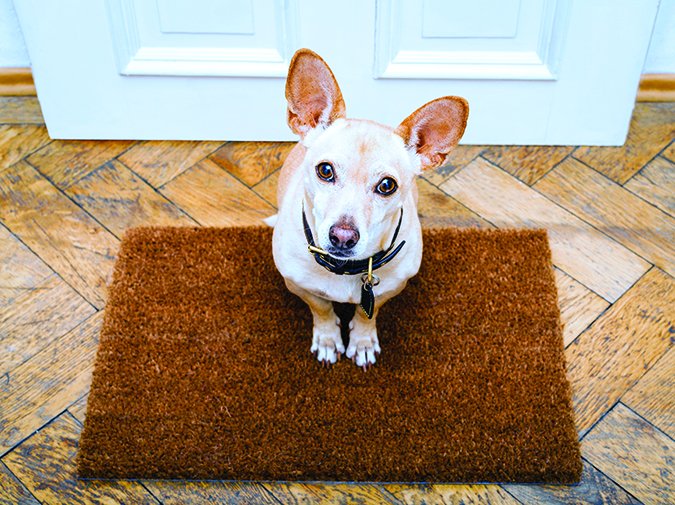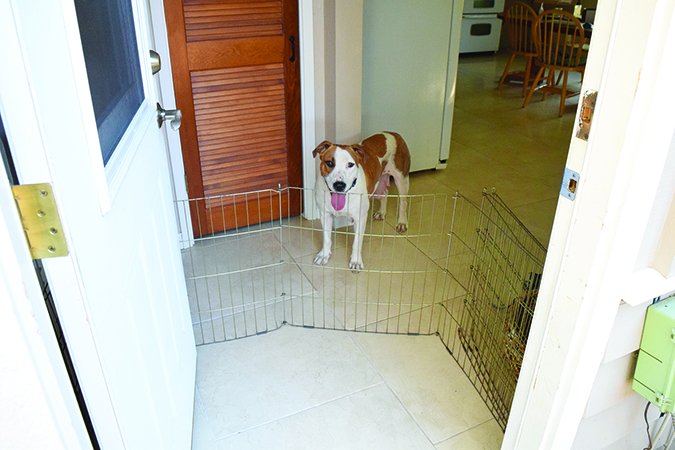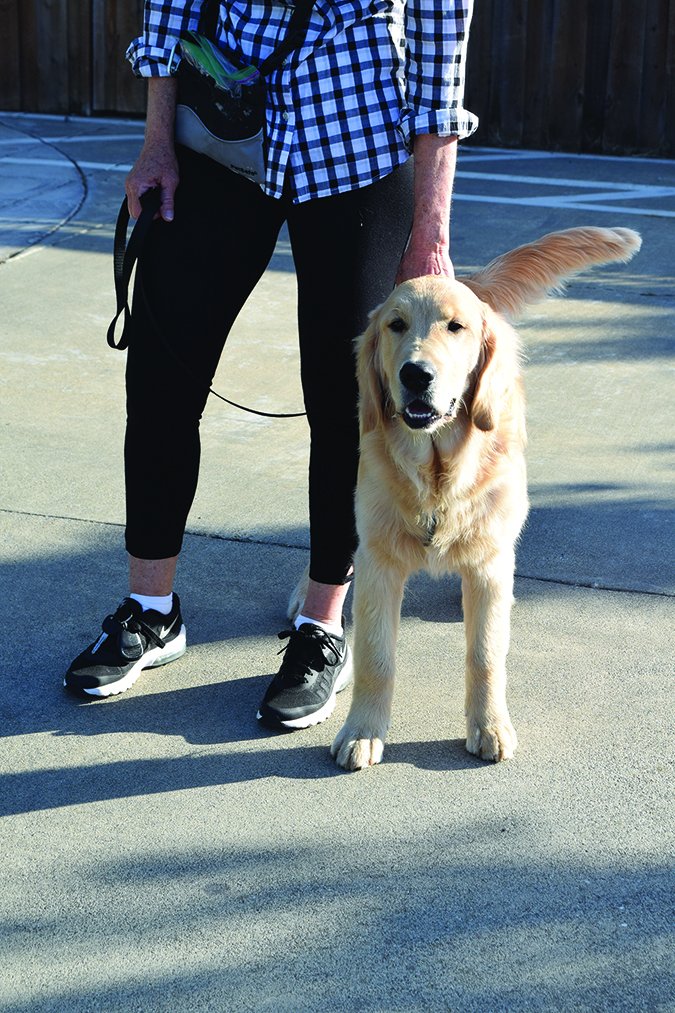Those of us who love dogs tend to assume that everyone else in our circle of friends and family does, too. Sadly, that’s not always the case. In fact, even those who do share our passion for canine companions don’t always appreciate the over-enthusiastic attentions of a happy hound, especially when they are trying to enjoy the company of human friends in the comfort of a private home. Whether you are a visitor bringing your own beloved dog with you to someone else’s house, or a host greeting friends at your own front door with your canine family members milling about your feet, here are some tips to help you make sure your dog/human visits go well.
When You Are the Visitor
If you’re headed for a visit to friends or family and you plan to take your dog along, it’s important that you make sure ahead of time that she will be welcome – both now and in the future. Here’s how:

Ask first!
It might be hard to imagine that any close friends or family members of mine would object to a with-dog visit, but it’s far better not to assume. There could be many valid reasons why your dog(s) might not be welcome, including (but not limited to):
• Lease provisions that prohibit the presence of pets
• Allergies by one or more residents in the home
• A dog in the home who is not dog-friendly
• Dog fears or phobias by one or more residents (human or otherwise) in the home
• Past bad experiences with visiting dogs (yours or others)
If your host-to-be expresses a strong preference to not have your dog visit with you, respect that wish.
Bring a friendly dog.
If you want to take your dog visiting with you, she should be friendly and well socialized. There is no excuse for bringing along an aggressive dog, thereby risking the safety of others as well as that of your own dog. You would feel awful – and would be legally and morally responsible – if your dog bit or mauled someone during your visit. Plus, many dogs who are forced into situations they cannot handle bite defensively and often end up with a “dangerous dog” label and are ultimately euthanized.
Have a clean canine.
A dirty, smelly dog who sheds all over the house is not a great canine ambassador. Make sure your dog is well groomed prior to your visit and be prepared to wipe paws clean before entering the home. If it’s the time of the year when shedding normally happens, or if your dog is a year-round heavy shedder, warn your host in advance, and offer to do fur clean-up duty at the conclusion of your visit before you leave.
Have a pest-free canine.
Fleas and ticks are even worse than a little doggy dirt and hair. Fleas can hop off your dog and infest a house (and other warm-blooded residents) even long after you are gone. Ticks, carriers of several significant zoonotic (transmissible to humans) diseases including Lyme, ehrlichiosis, and Rocky Mountain spotted fever, can also drop off your dog and climb onto others – and bite or attach to them.
With today’s very effective flea-control products, there are no excuses for having fleas on your dog. Ticks can hitch a ride on your dog despite tick-preventive products (the products are supposed to kill them within 24 hours before they can transmit disease, but don’t prevent them from climbing aboard), so either avoid tick territory for at least 24 hours prior to visiting others, or do a very thorough check for ticks before you arrive.
Train your dog.
At the very least, your dog should be the graduate of a basic force-free good manners class or equivalent training program, be appropriately friendly and social with other humans and friendly with dogs and any other species that might inhabit your host’s home. Polite greeting behavior is a must. More advanced training is even better!
No house soiling or counter surfing allowed, or chewing on non-chew objects. Even if your dog is allowed on furniture in your own home, when your dog is in someone else’s home, getting on the sofas and other furniture should be by invitation only.
Manage your dog.
If your dog is generally social but isn’t yet solid on all her good-manners behaviors, then management is a must. The umbilical cord method is called for here, with you keeping your dog leashed and at your side to prevent any possible social lapses. Crates and portable exercise pens are options for those moments when you want to take a break from your own dog. The leash also allows you to restrain your dog while you inquire whether others want to interact with her, and gives you real-life opportunities to practice her polite greeting behavior. (See “Your Dog’s Behavior: When to Manage, When to Train“.)
If there are children present in your host’s home, you must supervise interactions between your dog and the young humans 100 percent of the time. Even if you are totally confident your dog is good with children, you never know; a child may not know how to be appropriate with your dog and do something that would cause any dog to snap. You must not only supervise, but also be keenly aware of your dog’s body language and intervene if you see any signs that your dog is less than delighted about the attentions of a child. (See “Listening to Your Dog’s Body Language“.)
© Damedeeso | Dreamstime.com

Potty Before Entering
When humans drive to the home of another human for a visit, they usually want to get out of their cars and go to their friends’ front door as quickly as possible, in a rush to greet their friends – although, sometimes the rush is to ask to use the restroom, especially after a long drive. People often forget that their dogs might also have to use the restroom after a drive, and shortly after they enter their friends’ homes, they are upset and dismayed when their ordinarily housetrained dog pees on their friends’ carpet. Whoops!
If you are going to visit a friend’s house with your dog, before approaching your friends’ front door, walk your dog up and down the sidewalk or in the front yard until she goes potty. Or, if she doesn’t do what you suspect she might have to do, keep her on a leash in your friend’s home and take her outside several times; don’t allow her to be loose or unattended in your friend’s home until you are certain she won’t have an accident. You never know; if your friend has a dog whose own housetraining is not perfect, your dog may detect the scent (perhaps undetectable to your nose) of a past “accident” and conclude that pottying indoors is okay. She’s much less likely to do so if she’s already empty.
Be doubly alert if your dog tends to urine-mark (lift his leg). Under the minor stress of visiting a home where other dogs live, he just might feel compelled to mark indoors, or in an outdoor location (such as on the corner of a nice wicker outdoor sofa or on the back porch rail) where your friend won’t appreciate this.
If you are the resident and your dog is prone to submissive urination or urinating in excitement when people arrive, try to take her outside to go potty as close as possible to the arrival time of your visiting friend. It might also be a good idea to bring her outdoors to greet your friend and his dog, so you don’t have to interrupt your greeting to clean up urine in the house.
When You Are the Host
When you are a dog-owning host, you have a different but similar set of responsibilities to ensure that your guests are comfortable with their canine encounters in your home:
Consider your dog’s needs.
You may have a lovely dog who just doesn’t do well with visitors. It will be challenging to fulfill your role as a host if you are constantly worried about your own dog’s behavior. If she will happily and quietly hang out in a bedroom while your guests are present, put her away so you can enjoy the occasion without stress.
Note: Do not crate or otherwise confine your dog where she will be forced to accept attentions of your visitors. A fearful or unsocialized dog who is crated or tethered might feel trapped and is likely to become even more defensively aggressive if confined where visitors will pass closely by, look at or speak to her, or even worse, poke fingers into a crate or attempt to touch her.
Frozen stuffed Kongs or other long-lasting food toys, with your dog crated if necessary to prevent guarding, can help keep her happy and quiet. If your dog won’t deal well with being isolated in another room, consider asking a friend or family member to take her for the duration of your guests’ visit, or board your dog at a well-researched force-free boarding facility. Note: If you put your dog in another room due to possible aggressive behavior, I strongly recommending padlocking the door to prevent accidental entry into the dog room with potential tragic consequences.
Consider your visitors’ needs.
As lovely as your dog may be, you might, on occasion, have visitors who just don’t appreciate canine attention, hair, or saliva. Perhaps your guest has significant allergies, or is very fearful of dogs.
If you don’t already know how they feel, ask your guests ahead of time if they are comfortable with dogs, and respect their wishes. If they have strong negative feelings, even if your dog is quite friendly, make arrangements as above for your dog to be elsewhere during the visit – either enclosed in another room, at a friend’s house, or boarded.
If you’re not willing to accommodate your guests’ needs by restricting your dog’s access, then don’t invite those guests to your home. Perhaps you can meet them at a restaurant for dinner instead.
Exercise your dog well prior to the arrival of guests.
I like to say, “A tired dog is a happy human.” Be sure to leave time during your visitor preparations for a good exercise session with your dog an hour or so before your company arrives. She may still be excited when guests first walk in, but with much of her energy recently expended, she will settle down and relax much more quickly – and so can you.
Orchestrate controlled greetings.
Even those of us who love dogs don’t necessarily enjoy being bowled over by an enthusiastic canine greeter. If you have one of those, you have several options for orchestrating polite greetings at the front door:
• Confine your dog away from the door until your guest is greeted and settled. You can close your dog in another room, crate her, use baby gates to block her access to the front door, or tether her near the door so she can watch the action but not participate until released. If you use baby gates or tethers, you can invite your guest to help with training by giving him treats and asking him to approach your restrained dog and give her a treat when she sits.
• If your dog has learned a default sit for a treat, you can ask your guests to do a “treat and greet.” Keep a waterproof container of non-perishable treats outside your front door, and ask your guest to help himself to several before he enters the house. When he does, coach him to hold the treat near his chest (or whatever body language signals a sit to your dog) and then give your dog a treat when her bottom is securely resting on the floor. Alternatively, you can have him play “Find it!” with your dog by tossing small handfuls of tiny treats on the ground, thereby redirecting your dog’s attention – and her energy – away from himself and toward the floor.
• Here is an alternative for dogs who will default-sit for a toy: Keep a basket of toys outside your front door. Ask your guest to grab a couple of toys on the way in and wait for your dog to sit; as soon as she does, have your guest toss a toy a good distance away. Your dog may run after it and play with it or bring it back to your guest. If she brings it back, he can prompt a sit with the second toy, and then toss that one. The dog will likely drop the first as she runs after the second.
• You can also use high-tech options like the Treat & Train or Pet Tutor. These remote-controlled devices can be used creatively to invite your dog away from the door as your visitors enter.
Train your dog.
Of course, good socialization and training are always your best options. At the very least, your dog should be the graduate of a basic force-free good manners class or equivalent training program, be appropriately friendly and social with other humans (and any other species your guests may be bringing with them). Polite greeting behavior is a must. More advanced training is, of course, even better! A well-trained “go to your place” behavior can be invaluable for helping your guests feel comfortable with your dog’s presence.

Manage your dog.
As described in the “Visitor” section, if your dog isn’t reliably trained and generally well-behaved, or if you just want a break from dog-supervision duties, then management is a must. Leashes, tethers, baby gates, crates, and closed rooms are all viable management options to help keep things under control when guests are in your home. And, even if your dog is allowed on furniture, be courteous and give your guests the option of not sharing the sofa with your dog if they’d prefer not to do so.
If your visitors are bringing children with them, you must supervise interactions between your dog and the young humans 100 percent of the time, even if you are totally confident your dog is good with children. You must not only supervise, but also be keenly aware of your dog’s body language and intervene if you see any signs that your dog is less than delighted about the attentions of a child. Err on the side of caution.
And finally, do not rely on your guests to do the supervising. They don’t know your dog and may not be skilled at reading and understanding her body language signals of stress or discomfort.

Fair Warning
Don’t take your friend’s dog’s training for granted. Perhaps your dog has been trained to never run out of your front door without explicit permission, but a door left open just for a few moments (say, to fetch more groceries from the car) might be the beginning of a tragic lost-dog saga if your friend’s dog lacks this training skill. Your cat or parrot might be safe from your dog, but can lose their lives in a matter of moments if your friend’s dog is more predatory and your unsuspecting pets were in harm’s way.
Though it’s hard to anticipate every potential tragedy that can occur with dogs in new places, alert your friend to the most likely dangers to her dog or to your family members. Let her know if your yard is not securely fenced, for example, or where your chicken or rabbit pen is located.
Keep in mind that a portable exercise pen is a terrific management tool that can be deployed to prevent lots of disasters. If your friend’s dog is a door-darter, you can set up a pen in an “air-lock” arrangement, so she can’t escape if the door is left open by accident, or so someone who is not savvy about the door-darter’s techniques can’t accidentally let her escape. You can also use an exercise pen to create a larger safe zone for your bird’s cage or your elderly cat’s food bowls and litter box.
We, the Dog Lovers
It really is incumbent on those of us who love dogs to make sure that others have good experiences with our canine companions, whether they are guests in our homes, or we are guests in theirs. Regardless of the circumstances, and regardless of your dog’s training and socialization, wherever you are you must always be on the alert for signs that your dog is stressed and needs a break, or that others are uncomfortable with her presence and you need to give them a break. Without that, our dogs will continue to find themselves less welcome and less appreciated by the rest of the world.
In contrast, though, every good canine ambassador will help open doors for dogs in the world, rather than closing them.
Author Pat Miller, CBCC-KA, CPDT‑KA, is WDJ’s Training Editor. She and her husband Paul live in Fairplay, Maryland, site of her Peaceable Paws training center. Miller is also the author of many books on positive training. Her newest is Beware of the Dog: Positive Solutions for Aggressive Behavior in Dogs.





